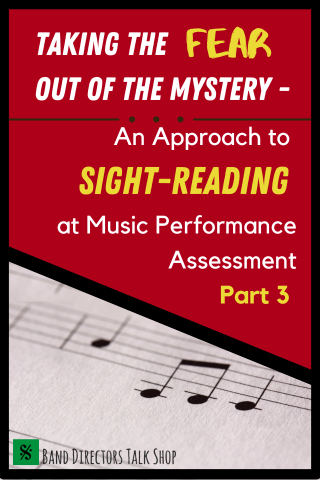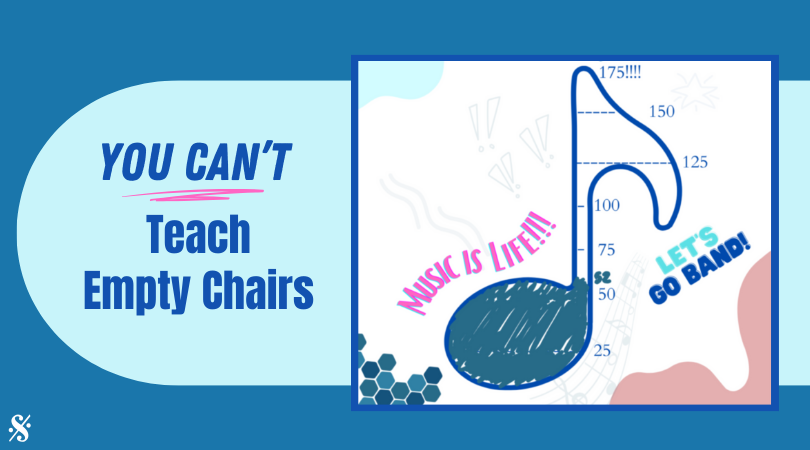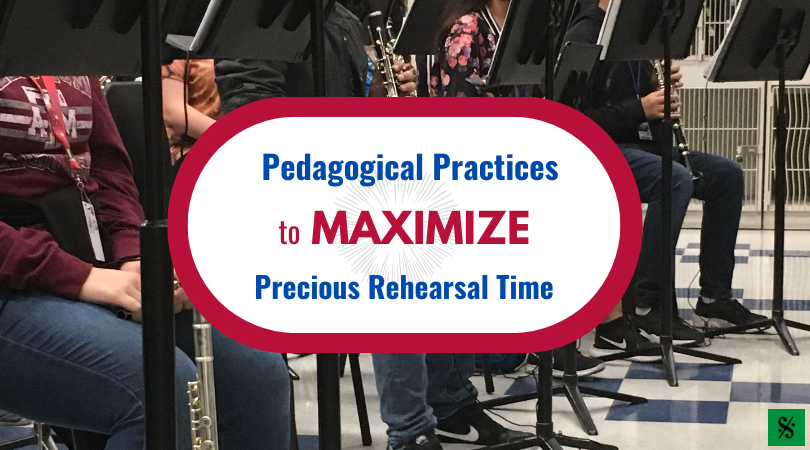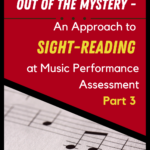Be sure to read Part 1 & Part 2 of this sight-reading series first!

The “Process”
Most sight-reading events offer a study period before reading a brand-new piece. The amount of time given depends on the grade level and difficulty of the music. What you are allowed to do with your students can also vary. Again, you must understand the governing organization’s rules and regulations thoroughly. Often, directors can count and talk during the study period but not during the performance period. Commonly, students may not play their instruments during the study period.
Some events allow students to “sizzle” while fingering through the music but not to put air into their instruments. This is as close to playing the instrument as you can get during the study period. We wanted the students to “feel” as if they had already played the music without having played a note. A word of caution: if playing is not allowed, do not allow students to blow air through their instruments. An inadvertent note could begin the sight-reading exercise before the study period ends! The students should keep their instruments on their knees or laps during the study period. Students should make every effort to mimic playing the music while never playing a note.
A lot of music can be taught using this process. You can still hear the students perform rhythms, dynamics, and style. This allows you to correct errors you may hear. Additionally, younger students hear how the older, more seasoned students are sizzling and will follow them. It is vitally important that ALL students buy into this process and” go for it” with conviction. Remember, the judge is watching how the conductor teaches but is also watching to see how well the students are engaged in the process. ANY student not fully participating can be a negative for the rest of the group. The percussionists are the most visible players in the group and are the easiest to pick out if they are not 100% engaged.
As you go through this process, keep an eye out for unusual rhythms, etc. Don’t be afraid to stop and rep these spots as needed. Be mindful of tempo changes, key changes, and time signature changes. Each area can be “rehearsed” with the band while sizzling. Also, be aware of commonly missed notes. (A concert, E concert, Db concert, etc.) Dynamics and changes in dynamics can also be heard and rehearsed while sizzling. Be aware of odd or shortened phrases that might not “feel” right to younger musicians. Check for percussion breaks and odd or awkward interval skips in the wind parts. Do not hesitate to stop at these spots and rep them 3-4 times before going on. This is still a rehearsal in every sense of the word, except students simply are not playing their instruments.
Above all else, go for the music, even in the sizzle!
With any remaining time, review the problem spots. Most judges will give you a 2-3 minute “warning” before your time is up. In Texas, the grade 1-3 pieces are short enough to rehearse the entire piece a second time! The grades 4-6 pieces are longer, and you most likely wouldn’t be able to get through the entire piece again, but you can hit the “hot” spots and drill those.
Sight-Reading Performance Time
Following the study period, you may get a brief warm-up/tune time. Consider warming up on the scale the piece is in if allowed. If there is a key change, review that scale as well. Check to make certain that the timpani is tuned correctly.
Take care that your tempos are not too fast or too slow. Avoid creating a ‘tempo’ induced problem for your students. Generally, tempos are perceived as either fast or slow. If you have a tempo change, you need only make an approximated difference. Allegro can go a little slower, and adagio can go a little faster as long as the style and mood of the piece are not altered.
Raise your non-conducting hand a few measures before a rehearsal mark, dropping it as you cross it. This will give your students added confidence that they are in the correct place in the music.
When you are done, be certain to thank the judge!
Judge’s Perspective
It is important to know the judge is on your side and is pulling for you and your students! An occasional missed note or blown rhythm will not affect your sight-reading score as long as students can make corrections quickly. Groups with engaged students will not always have a superior performance, but groups not engaged will most certainly NOT have a superior performance.
Make Sight-reading a POSITIVE Event
Your demeanor will set the stage for either a positive experience or one fraught with anxiety. Working with a relaxed, professional demeanor will de-escalate any anxiety your students might be experiencing. Adopting a relaxed “you’ve got this” attitude will reduce stress and tension in the room. Have a sense of humor and enjoy the experience.
PREPARE ahead of time! Work on the quality of sound at EVERY rehearsal. Start building rhythm skills needed during the first semester. Remember, reading rhythms is a skill like reading words in a book and must be built over a long period of time. Time can be your friend…or your enemy.
Enjoy your sight-reading process, “Let’s see what this piece is about!”
Jon Bubbett is a retired band director from Alabama with over 40 years of teaching experience. He has presented at The Midwest Clinic and other states’ Music Education Associations. He has presented clinics throughout the southeast and has music published through Excelcia Music Publishing, Belwin Music, Eighth Note Publishing, RWS, and jonbubbettmusic.com.
Related Reading:
Rhythmic Placement – Playing with Musicality
“Out of the Box” Rhythm Exercises
Sight-Reading Room Hints for Young Teachers
If you would like to receive our weekly newsletter, sign up here.
Don’t forget to like us on Facebook too!
Learn. Share. Inspire.
BandDirectorsTalkShop.com






Leave a Reply
You must be logged in to post a comment.